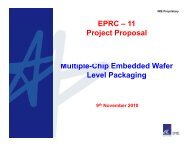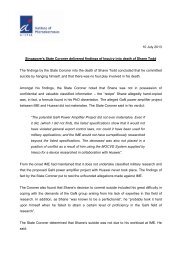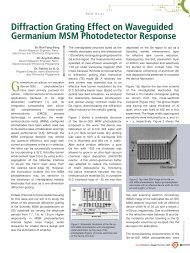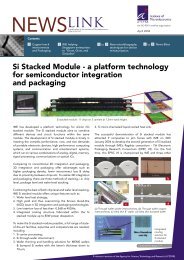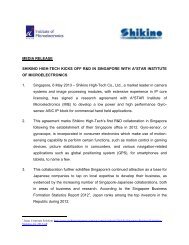3D Packaging with Through Silicon Via (TSV) - Institute of ...
3D Packaging with Through Silicon Via (TSV) - Institute of ...
3D Packaging with Through Silicon Via (TSV) - Institute of ...
Create successful ePaper yourself
Turn your PDF publications into a flip-book with our unique Google optimized e-Paper software.
Copyright © 2009 Year IEEE. Reprinted from 2009 Electronic Components and<br />
Technology Conference. Such permission <strong>of</strong> the IEEE does not in any way imply IEEE<br />
endorsement <strong>of</strong> any <strong>of</strong> <strong>Institute</strong> <strong>of</strong> Microelectronics’ products or services. Internal <strong>of</strong><br />
personal use <strong>of</strong> this material is permitted. However, permission to reprint/republish this<br />
material for advertising or promotional purposes or for creating new collective works for<br />
resale or redistribution must be obtained from the IEEE by writing to pubspermission@ieee.org.
<strong>3D</strong> <strong>Packaging</strong> <strong>with</strong> <strong>Through</strong> <strong>Silicon</strong> <strong>Via</strong> (<strong>TSV</strong>) for Electrical and Fluidic Interconnections<br />
Navas Khan*,Li Hong Yu*, Tan Siow Pin*, Soon Wee Ho*, Nandar Su*, Wai Yin Hnin*, Vaidyanathan Kripesh*,<br />
Pinjala*, John H. Lau*^, Toh Kok Chuan**<br />
* <strong>Institute</strong> <strong>of</strong> Microelectronics, A*STAR (Agency for Science, Technology and Research), 11 Science Park Road,<br />
Science Park II, Singapore 117585; Email: oknavas@ime.a-star.edu.sg<br />
** School <strong>of</strong> Mechanical and Aerospace Engineering, Nanyang Technological University,<br />
50 Nanyang Avenue, Singapore 639798<br />
^Now <strong>with</strong> Hong Kong University <strong>of</strong> Science & Technology<br />
Abstract<br />
In this paper a liquid cooling solution has been reported<br />
for 3-D package in PoP format. The high heat dissipating<br />
chip is mounted on a silicon carrier, which has copper<br />
through-silicon via for electrical interconnection and throughsilicon<br />
hollow via for fluidic circulation. Heat enhancement<br />
structures have been embedded in the chip carrier. Cooling<br />
liquid, de-ionized water is circulated through the chip carrier<br />
and heat from the chip is extracted. The fluidic channels are<br />
isolated from electrical traces using hermetic sealing. The<br />
research work has demonstrated 100 W <strong>of</strong> heat dissipation<br />
from one stack and total <strong>of</strong> 200 W from two stacks <strong>of</strong> the<br />
package. The fluidic interconnections and sealing techniques<br />
have been discussed.<br />
Introduction<br />
System in a Package (SiP) combines semiconductors,<br />
passives and interconnects in one package, enabling higher<br />
system integration. Three-dimensional (3-D) packaging is the<br />
preferred technology for many SiP design because <strong>of</strong> the<br />
advantages <strong>of</strong> smaller size, shorter signal routing, and<br />
reduced wiring density at the second level. 3-D packaging is<br />
achieved by different techniques viz. die level stacking,<br />
package level stacking, and wafer level stacking. However,<br />
current 3-D package applications are limited to die and<br />
package level stacking for lower power applications such as<br />
memory devices, base band, and logic devices. On the other<br />
hand, the high packaging efficiency <strong>of</strong> <strong>3D</strong> stacking leads to<br />
the concentration many heat producing elements in a small<br />
volume, resulting in very high flux.[1] The power density <strong>of</strong> a<br />
single chip packaging is incessantly increasing and is<br />
expected to be higher than 100 W/cm 2 for high performance<br />
systems, such as defense systems. [2] Moreover, the space<br />
between the stacked modules is much less than 1mm, which<br />
reduces the physical space available for coolant. Thus, an<br />
integrated cooling solution is required for such application.<br />
Air-cooling is simple, low cost, and reliable cooling<br />
solution. However, the low thermal conductivity and low<br />
density <strong>of</strong> the air make it less attractive as a coolant for high<br />
heat flux 3-D packages. Liquid cooling using micro-channels<br />
is a suitable option for such application. An assessment <strong>of</strong><br />
cooling schemes available for such high heat flux<br />
applications was done <strong>with</strong> phase change cooling (Boiling)<br />
able to handle heat fluxes above 100W/cm 2 .[3] However, its<br />
application is <strong>of</strong>ten hindered by its unpredictable nature.<br />
Hence, single phase cooling using micro-channels is applied<br />
in this work. Different cooling liquid for the single phase<br />
cooling was considered, and DI water had been identified due<br />
to its better thermal properties (i.e. higher thermal<br />
conductivity).<br />
Many researchers have explored the advantages <strong>of</strong> using<br />
liquid cooling to tackle high heat flux problem [4-6]. But<br />
many challenges have not been addressed for the integration<br />
<strong>of</strong> liquid cooling in 3-D package such as embedding microchannels<br />
in the chip carrier, 3-D fluidic interconnection and<br />
fluidic sealing. In this work, a novel integrated liquid cooling<br />
technique for 3-D <strong>Silicon</strong> modules is developed. The cooling<br />
solution enables extraction <strong>of</strong> heat from the chip mounted on<br />
a silicon chip carrier and provides fluidic interconnects<br />
between two chip carriers stacked vertically. The cooling<br />
solution is designed such that no external fluidic<br />
interconnections are required to assemble the package on the<br />
mother board. Other components such as pump, heat<br />
exchanger have been assembled along <strong>with</strong> the 3-D package.<br />
Integrated cooling solution design<br />
The <strong>3D</strong> package consists <strong>of</strong> two carriers assembled one<br />
over other <strong>with</strong> silicon interposer. Each carrier is mounted<br />
<strong>with</strong> 10mm x10mm chip <strong>with</strong> heating and temperature<br />
sensing elements. Heat transfer enhancement structure is<br />
designed as a part <strong>of</strong> the carrier to extract the heat generated<br />
by chip. The stacked module is then attached to a printed<br />
circuit board using 300µm solder balls. The footprint <strong>of</strong> the<br />
<strong>3D</strong> package is 15mm by 15mm <strong>with</strong> a height <strong>of</strong> 2.8mm. The<br />
liquid cooling solution consists <strong>of</strong> the following components<br />
in addition to the package: (1) A mini-pump (2) an adapter<br />
for flow distribution and (3) a heat exchanger. A schematic <strong>of</strong><br />
the cooling solution is shown Fig. 1. Electrical and fluidic<br />
connectivity between carriers is achieved by <strong>TSV</strong>. In this<br />
arrangement, heat from the chip is transferred to the carrier,<br />
and it is transported to the heat exchanger to be rejected to the<br />
ambient.<br />
Heat Exchanger<br />
Chip 1<br />
Carrier 1<br />
Interposer<br />
<strong>TSV</strong><br />
Fluid out<br />
Mini Pump<br />
PCB<br />
Fluid in<br />
Mechanical<br />
connector<br />
Gasket<br />
Adaptor<br />
Chip 2<br />
Carrier 2<br />
Solder ball<br />
Fig. 1 Scheme <strong>of</strong> the integrated liquid cooling system for <strong>3D</strong><br />
stacked module (non-scaled)<br />
978-1-4244-4476-2/09/$25.00 ©2009 IEEE 1153 2009 Electronic Components and Technology Conference
Thermal design <strong>of</strong> the chip carrier and <strong>3D</strong> module has<br />
been done using commercial CFD package ICEPAK. Onedimensional<br />
thermal resistance network model was used as a<br />
first order estimate <strong>of</strong> various thermal resistances in the<br />
package and their contribution to the overall thermal<br />
resistance. Chip interconnection thermal resistance is<br />
calculated based on area-averaged conductivity <strong>of</strong> solder<br />
balls and underfilling material. The one dimensional model<br />
predicted a junction temperature <strong>of</strong> 98°C based on an inlet<br />
temperature <strong>of</strong> 50°C. The resistance <strong>of</strong> the chip interconnect<br />
is 57% <strong>of</strong> the overall thermal resistance, remaining 43% is<br />
chip carrier thermal resistance. Hence, we investigated<br />
enhancement techniques to improve the heat transfer and<br />
reduce the R interconnects and R carrier .<br />
Liquid<br />
Inlet<br />
Fig. 2 One dimensional thermal resistance model<br />
S<br />
gen,thermal<br />
Chip<br />
Carrier <strong>with</strong> micro-channel<br />
2<br />
Q <br />
<br />
R<br />
T<br />
ref <br />
*<br />
S S<br />
heat sin k<br />
gen,thermal<br />
* S<br />
Liquid<br />
Outlet<br />
S<br />
gen,dP<br />
gen,dP<br />
<br />
R Interconnection<br />
R Carrier<br />
dP * G<br />
T<br />
ref<br />
respective entropy generation. The trend in Fig 3 showed that<br />
optimum microchannel spacing is found to be in the region <strong>of</strong><br />
80 microns and 110microns for the microchannel depth<br />
investigated. Microchannel size <strong>of</strong> 100µm width and 350µm<br />
depth has been taken based on the balance between the<br />
thermal resistance and pressure drop.<br />
A common micro-channel arrangement reported in the<br />
literature is single inlet / outlet arrangement (S1). The flow<br />
enters from one end <strong>of</strong> the channels and flow through the<br />
entire length <strong>of</strong> the channels and is collected at the outlet.<br />
This is a parallel plate type <strong>of</strong> micro-channel heatsink which<br />
has some disadvantages. The pressure drop across a channel<br />
is high due to the long flow length. The heat transfer per unit<br />
length is also lower as the developed region is a substantial<br />
portion <strong>of</strong> the total flow length.<br />
The flow distribution across channels is governed by<br />
pressure differences between the supply and return plenum.<br />
The conversion <strong>of</strong> static and dynamic pressure changes the<br />
pressure pr<strong>of</strong>ile <strong>with</strong>in the plenum. Hence, it is desirable to<br />
distribute flow such that the heat transfer per unit area <strong>with</strong>in<br />
the channels is the same to minimize temperature variation.<br />
Therefore a split flow arrangement (dual-port) has been<br />
developed for this work. Schematic <strong>of</strong> the single port and<br />
dual -port design is as shown in Fig 4. There are two fluidic<br />
inlets and two outlets. This arrangement has the benefit <strong>of</strong><br />
reducing the flow length, <strong>with</strong> the thermal developing length<br />
being a substantial portion <strong>of</strong> the channel length. The mixed<br />
mean temperature (T m ) <strong>of</strong> the cooling liquid in the channels is<br />
lower and hence heat rejection occurs across a smaller<br />
temperature difference (T w -T m ). As frictional pressure drop is<br />
proportional to flow length (4fL/D h ), the shorter length will<br />
reduced the pressure drop significantly.<br />
Fig. 3 Micro-channel optimization<br />
A chip carrier has been designed <strong>with</strong> microchannels to<br />
remove the heat from the chip to the cooling liquid.<br />
Numerical analysis is performed to optimize the carrier<br />
thermal resistance. Parametric study on channel dimensions is<br />
performed to understand its impact on the carrier<br />
performance. Pressure drop and thermal resistance <strong>of</strong><br />
different channel spacing versus channel depth between<br />
250µm to 400µm have been analyzed. A constant flow rate <strong>of</strong><br />
water at 200ml/min is taken for the analysis. Microchannel<br />
geometry is optimized by considering viscous and thermal<br />
effects simultaneously [7]. The entropy generation due to<br />
hydraulic losses and heat transfer are combined as an<br />
optimization parameter S*, given by the product <strong>of</strong> the<br />
Fig. 4 Chip carrier design: (Left) Single port design, (Right)<br />
Dual-port design<br />
We evaluated two designs <strong>of</strong> the split flow arrangement<br />
such as, design 1 (D1) has a constant supply and return<br />
plenum width and design 2 (D2) has reducing width <strong>of</strong> supply<br />
plenum. Due to the symmetry in geometry and boundary<br />
conditions <strong>of</strong> the carrier design, a quarter-model was<br />
developed for the numerical analysis. The fin thickness <strong>of</strong><br />
50m, the channel width <strong>of</strong> 100m and channel depth <strong>of</strong><br />
350m is taken for the analysis. The supply plenum width<br />
is150m and the return plenum is 250m. The inlet<br />
temperature <strong>of</strong> the water is assumed to be 50ºC for all the<br />
analysis.<br />
Numerical simulation results have been compared among<br />
the three designs. Temperature distribution <strong>of</strong> the chip is<br />
1154 2009 Electronic Components and Technology Conference
shown in Fig. 5. Table 1 showed the pressure drop across the<br />
carrier and the die temperature pr<strong>of</strong>ile. Comparing between<br />
the single port and the dual-port design, it is very clear that<br />
the dual-port designs has lower thermal resistance and<br />
reduced pressure drop. As the pump size is proportional to<br />
pressure drop, a smaller pump can be selected for the cooling<br />
design. Comparing D1 and D2, D2 has the lower thermal<br />
resistance (peak chip temperature) and small temperature<br />
variation. Thermal performance improvement is due to the<br />
uniform heat picked up in each channel. Flow distribution in<br />
each channel has been analyzed for the three designs. For S1,<br />
the flow distribution is better, but the long channel length<br />
leads to high temperature gradient. Design D1 has nonuniform<br />
flow distribution among the channels, which reduced<br />
the microchannel effectiveness. For D2, the flow distribution<br />
is uniform, except for the first 3 channels. Hence, we have<br />
selected design D2 for the fabrication and characterization.<br />
Fig. 5 Temperature contours on chip at 100ml/min: (Left) S1,<br />
(Top Right) D1, (Bottom Right) D2<br />
bonding, electrical interconnection through the carrier is<br />
made by <strong>TSV</strong> <strong>with</strong> on wall metallization.<br />
The chip carrier fabrication process begins <strong>with</strong> an 8”,<br />
725µm thick wafer (Fig. 6a). A 3µm thick silicon dioxide<br />
(SiO 2 ) layer is deposited on the wafer by plasma enhanced<br />
chemical vapor deposition (PECVD) and the <strong>TSV</strong>/ microchannels<br />
are patterned (Fig. 6b). This is followed by a 2µm<br />
thick photoresist coating and patterning for the via (Fig. 6c).<br />
As the depth <strong>of</strong> the <strong>TSV</strong> and micro-channels are different, the<br />
<strong>TSV</strong> is etched to 230µm deep, then the photoresist mask is<br />
stripped (Fig. 6d). Then <strong>TSV</strong> and micro-channels are etched<br />
using SiO 2 mask further to the depth <strong>of</strong> 170µm (Fig. 6e). The<br />
SiO 2 layer is then stripped by BOE (Fig. 6f). The backside <strong>of</strong><br />
the wafer is then grinded to 400µm thickness to expose the<br />
vias (Fig. 6g). A 1µm thick SiO 2 is then deposited on the<br />
channel side and back side <strong>of</strong> the wafer (Fig. 6h). Under<br />
Bump Metallization (UBM) is deposited and patterned on the<br />
channel side and back side <strong>of</strong> the wafer (Fig. 6i & 6j). 1µm<br />
thick SiO 2 is deposited on the back side and patterned for the<br />
carrier passivation layer (6k). The fluidic ports are then laser<br />
drilled (Fig. 6l). The Au/Sn solder is then deposited on the<br />
channel side and patterned (Fig.6m). The carrier fabrication<br />
process is completed by bonding two such wafers together at<br />
350°C for 15 minutes <strong>with</strong> a compressive strength <strong>of</strong> 4.7MPa<br />
(Fig. 6n). The UBM material used is Ti/Cu/Ni/Au <strong>with</strong><br />
thickness <strong>of</strong> 0.1μm, 1μm, 0.5μm and 0.1μm, respectively.<br />
The electrical <strong>TSV</strong> are connected by sputtering the UBM<br />
layer from front and back side <strong>of</strong> the wafer. AuSn-solder<br />
system is selected as the bonding material <strong>of</strong> the wafers.<br />
Generally 80wt%Au - 20wt%Sn solder is widely used<br />
because <strong>of</strong> its advantages, such as high reliability, high<br />
strength, high corrosion resistance, no thermal fatigue and<br />
allows soldering in flux-less processes. A sealing ring <strong>of</strong><br />
300um width around the micro-channels and fluidic ports has<br />
been designed to isolate the electrical <strong>TSV</strong> from the cooling<br />
liquid.<br />
Table 1: Thermal simulation results<br />
Flowrate<br />
(ml/min)<br />
100<br />
200<br />
Design<br />
Pressure<br />
drop<br />
(mbar)<br />
Maximum<br />
Temperature<br />
(°C)<br />
Temper<br />
ature<br />
variation<br />
(°C)<br />
S1 158.1 98.7 22.5<br />
D1 55.45 97.2 8.6<br />
D2 76.7 93.4 9.4<br />
S1 398.7 92.1 18.5<br />
D1 169.7 91.8 9.6<br />
D2 253.1 87.2 7.8<br />
Chip Carrier Fabrication<br />
The bottom carrier (CR1) and top carrier (CR2) has<br />
mostly the same construction except that CR1 has pads for<br />
PCB. The chip carrier has copper <strong>TSV</strong> for electrical<br />
interconnection and hollow <strong>TSV</strong> for fluidic circulation. <strong>TSV</strong><br />
are designed along the periphery <strong>of</strong> the carrier at a pitch <strong>of</strong><br />
500 μm. Totally there are 144 <strong>TSV</strong> for electrically<br />
interconnection and four hollow via for fluidic ports. After<br />
Fig. 6 Process steps involved in carrier fabrication<br />
1155 2009 Electronic Components and Technology Conference
The bonded carrier should have good bonding strength to<br />
<strong>with</strong>stand the dicing force and liquid pressure. The bonded<br />
carrier is sheared using DAGE-SERIES-4000-T, the shear<br />
strength value measured for 20 different samples ranged from<br />
17.8 MPa to 35.1 MPa, and an average value <strong>of</strong> 27.2 MPa<br />
and a standard deviation <strong>of</strong> 2.2 are obtained. The shear<br />
failure mode is silicon crack, the bonded interface is intact.<br />
Mini- Pump<br />
Heat Exchanger<br />
Flexible Tube<br />
Adaptor<br />
PCB<br />
Fig. 9 Photograph <strong>of</strong> integrated cooling solution<br />
Fig. 7 Cross section <strong>of</strong> the carrier <strong>with</strong> embedded microchannels<br />
<strong>3D</strong> Package Assembly<br />
The bonded carrier wafer is diced to 15mm x 15mm size<br />
using mechanical dicing tool. The assembly processes<br />
involves pick and place <strong>of</strong> the chip on the carrier and<br />
reflowed. Then solder balls <strong>of</strong> 300µm diameters are placed<br />
on the carrier 1 and reflowed. Two types <strong>of</strong> solder are used in<br />
the assembly namely SnAgCu reflowed at 255°C for 30s<br />
(pr<strong>of</strong>ile 1) and SnPb Solder reflowed at 220°C for 30s<br />
(pr<strong>of</strong>ile 2). The underfill is dispensed after the chip<br />
attachment <strong>with</strong> the carrier and carrier to the PCB.<br />
Flip-Chip<br />
Carrier 2<br />
Cooling solution performance characterization<br />
A schematic diagram <strong>of</strong> the experimental setup for<br />
hydraulic characterization is shown in Fig. 10. A variablespeed<br />
gear pump was used to provide the pressure head. A<br />
filter <strong>with</strong> 10 µm mesh filter element was used after the pump<br />
to remove particles suspended in the liquid. A flow meter<br />
was connected in the closed loop to measure the flow rates.<br />
The flow meter was calibrated in-house to achieve a<br />
measurement error <strong>with</strong>in 2%. The pressure drop across the<br />
<strong>3D</strong> package section was measured <strong>with</strong> a piezo-resistive<br />
pressure transducer. The uncertainty at the full range was<br />
estimated to be <strong>with</strong>in 0.2%.<br />
Pump<br />
Heat Exchanger<br />
Solder<br />
Interposer<br />
Carrier 1<br />
Filter<br />
PCB<br />
Fig. 8: Schematic <strong>of</strong> the <strong>3D</strong> package assembly<br />
Solder ball<br />
Flow Meter<br />
Pressure Gauge<br />
The fluidic interconnection at difference interfaces is one<br />
<strong>of</strong> the biggest challenges in this work. As the size <strong>of</strong> <strong>3D</strong><br />
package becomes smaller, the available area on the periphery<br />
<strong>of</strong> the package for the fluidic interface also becomes smaller.<br />
An adaptor is designed to distribute the fluid between heat<br />
exchanger, mini pump and the carriers. Other purpose for the<br />
adaptor is split the flow into two inlet ports. A cavity <strong>of</strong><br />
1.5mm depth precisely machined on bottom side <strong>of</strong> the<br />
adaptor to align <strong>with</strong> the fluidic ports on the <strong>3D</strong> package. On<br />
the top side <strong>of</strong> the adaptor, one inlet port is fabricated to<br />
deliver the fluid from the mini pump to the package and one<br />
outflow port to convey the fluid from the package to the heat<br />
exchanger. The two ports are fixed <strong>with</strong> ¼” tap and flexible<br />
tube is used for the connection. The fluidic interface between<br />
the adapter and the package is sealed using rubber gasket.<br />
The integrated cooling solution is shown in Fig. 9.<br />
<strong>3D</strong> Package<br />
Fig. 10: Schematic <strong>of</strong> the test set-up<br />
As a first step, leakage testing is conducted by running<br />
the system at the maximum pressure condition (flow rate is<br />
400 ml/min) for 30 minutes. No leakage was observed during<br />
this period, which indicates that the sealing is good. Then the<br />
total pressure drop due to adaptor and <strong>3D</strong> package was<br />
measured. Then pressure drop due to the adaptor alone was<br />
measured by removing the <strong>3D</strong> package. The pressure drop in<br />
the <strong>3D</strong> package is obtained by subtracting the adaptor<br />
pressure drop from the measured total pressure drop. In<br />
addition, the pressure drop <strong>of</strong> the heat exchanger was<br />
measured separately by replacing the adaptor and <strong>3D</strong> package<br />
1156 2009 Electronic Components and Technology Conference
<strong>with</strong> the heat exchanger. The system pressure drop comprises<br />
<strong>of</strong> head losses from (a) <strong>3D</strong> package (b) Adapter and (c) Heat<br />
exchanger. Losses in tubes and fittings are small due to the<br />
lower velocities <strong>with</strong>in and ignored. The average pressure<br />
drop <strong>of</strong> five packages is plotted in Fig 11. The dual- port<br />
carrier design helps to lower the total pressure drop in the<br />
package, <strong>with</strong> less than 200mbar at 400ml/min in a two<br />
stacked package. A maximum <strong>of</strong> 400ml/min is required for<br />
the package cooling. A miniature pump based on this<br />
pressure head and flow requirements has been selected. The<br />
miniature pump is only 16mm height, which meets the<br />
package height requirements.<br />
Pressure drop (mbar)<br />
250<br />
200<br />
150<br />
100<br />
50<br />
Pressure Drop in <strong>3D</strong> Package<br />
0<br />
100 150 200 250 300 350 400 450<br />
Flowrate (ml/min)<br />
Fig. 11 Pressure drop characterization results<br />
Chip interconnection thermal resistance is measured and<br />
compared <strong>with</strong> the simulation result. A thermal test chip <strong>of</strong><br />
10mm by 10mm size is attached on a large silicon substrate<br />
(22mm by 22mm). The assembly is then mounted onto a cold<br />
plate and a thin layer <strong>of</strong> thermal interface material is applied<br />
in between them. On the test chip, the diode temperatures are<br />
measured are at the middle, left and right corner location. The<br />
cold plate surface and silicon substrate surface temperature<br />
are also measured using thermocouples. A numerical model<br />
has been developed similar to the experimental setup to<br />
obtain chip and silicon substrate average temperatures, then it<br />
is used for interconnect thermal resistance calculation. The<br />
TIM thickness in the experimental setup is unknown,<br />
therefore the numerical model is solved iteratively by<br />
comparing the cold plate temperature in the model <strong>with</strong><br />
thermocouple reading from the measurement.<br />
The experimental setup to determine thermal<br />
characteristic <strong>of</strong> the <strong>3D</strong> package is similar to the arrangement<br />
shown in Fig. 11. The filter, flow meter and pressure gauge<br />
have been removed from the closed loop. Single and two<br />
stack package have been tested. For the stacked module, the<br />
bottom and top chip is powered up from 40W to 100W. The<br />
water inlet and outlet temperatures are measured to quantify<br />
the energy balance. All the tests have been performed <strong>with</strong><br />
water flowing at 200ml/min for each stack. For thermal<br />
resistance calculation, arithmetic mean <strong>of</strong> the three diodes in<br />
the chip is used to represent the average chip temperature. Fig<br />
12 shows average temperature rise <strong>of</strong> the chip from the<br />
cooling water inlet temperature <strong>with</strong> heat load from 40W to<br />
100W. Fig 13 shows thermal resistance <strong>of</strong> the <strong>3D</strong> package.<br />
Temp rise (ºC)<br />
70<br />
65<br />
60<br />
55<br />
50<br />
45<br />
40<br />
35<br />
30<br />
25<br />
20<br />
15<br />
10<br />
5<br />
Average Chip Temperature Rise<br />
20 30 40 50 60 70 80 90 100 110<br />
Power (W)<br />
Fig. 12 Temperature rise <strong>of</strong> the chip verses power dissipation<br />
Thermal Resistance (ºC/W)<br />
0.8<br />
0.7<br />
0.6<br />
0.5<br />
0.4<br />
0.3<br />
0.2<br />
0.1<br />
0<br />
Thermal Resistance<br />
Fig. 13 Total thermal resistance <strong>of</strong> the <strong>3D</strong> package<br />
The <strong>3D</strong> package total thermal resistance based on test is<br />
0.577±6% °C/W. The thermal resistance is calculated based<br />
on average temperature rise on the chip from inlet liquid<br />
temperature. From the experimental results, higher<br />
temperature rise has been recorded on the chip compared to<br />
the modeling results. The overall thermal resistance measured<br />
by experiment is 0.577°C/W compared to 0.41°C/W by<br />
simulation. The overall thermal resistance is broken down<br />
into R interconnects and R carrier to understand the contribution <strong>of</strong><br />
each resistance to the total. R interconnects thermal resistance <strong>of</strong><br />
0.207°C/W is found experimentally compared to 0.229°C/W<br />
by simulation <strong>with</strong> an absolute error <strong>of</strong> 10%. The test chip<br />
used for the package thermal characterization contains only<br />
400 solder bumps. Therefore R interconnects is large, which can<br />
be reduced significantly by increasing number <strong>of</strong> solder<br />
bumps.<br />
Table 2: Comparison <strong>of</strong> thermal resistance<br />
Board 1<br />
Board 2<br />
20 30 40 50 60 70 80 90 100 110<br />
Power (W)<br />
Board 1<br />
Board 2<br />
Model Experiment Error (%)<br />
R th (°C/W) 0.410 0.577 44.3<br />
1157 2009 Electronic Components and Technology Conference
The experimental and simulation results <strong>of</strong><br />
hydraulic/thermal performances <strong>of</strong> the carriers are showing<br />
several discrepancies. The thermal resistance measured is<br />
0.377ºC/W compared to 0.21ºC/W by simulation, which is<br />
44% difference. Possible reason for the differences in<br />
modeling and experimental results can be attributed to flow<br />
imbalance in the lower and upper sack <strong>of</strong> the <strong>3D</strong> module due<br />
to bubbles trapping, other flow obstruction. The second<br />
reason can be attributed to flow allocation between the two<br />
inlet ports in carrier. There is also a possibility that more flow<br />
through one port compared to other due to air bubble<br />
clogging or flow obstruction by the sealing ring.<br />
Conclusions<br />
In this research work, a novel liquid cooling solution has<br />
been developed for <strong>3D</strong> package <strong>with</strong> integrated cooling<br />
components like heat exchanger, pump, electrical and fluidic<br />
connectivity. The liquid cooling solution is based on<br />
microchannel heat sink design. The dual-port microchannel<br />
arrangement maximized the heat transfer enhancement,<br />
minimized temperature variation in the chip and lowered the<br />
pressure drop. A chip carrier <strong>with</strong> embedded micro-channels<br />
and fluidic manifolds has been developed. The chip carrier<br />
has been tested up to a flowrate <strong>of</strong> 400 ml/min and good<br />
sealing <strong>of</strong> the fluidic path was achieved. <strong>3D</strong> package thermal<br />
performance had also been characterized; the chip is powered<br />
up to 100 W / chip. Overall thermal resistance <strong>of</strong> the chip<br />
carrier is 0.577°C/W compared to simulation result <strong>of</strong><br />
0.41°C/W. Some important results <strong>of</strong> the research work are<br />
summarized below:<br />
1. Unique design <strong>of</strong> a silicon carrier <strong>with</strong> embedded microchannels<br />
for heat transfer enhancement<br />
2. Chip carrier <strong>with</strong> tapered micro- fin structures for<br />
uniform flow distribution and small temperature<br />
variation <strong>with</strong>in the chip (< 10°C @ 100 Watts / cm 2<br />
heat flux)<br />
3. Dual-port fluidic design to minimize the system pressure<br />
drop (< 500 mbar @ 400ml/min)<br />
4. Chip carrier design <strong>with</strong> copper through-silicon via for<br />
electrical interconnection and through-silicon hollow via<br />
for the fluidic circulation<br />
5. Fluidic sealing design and hermetic joint using Au/Sn<br />
solder for high pressure flow requirements up to 0.8 Bar<br />
6. Micro-to-Macro fluidic interconnection method to<br />
connect 500um size holes in the module <strong>with</strong> 4mm hole<br />
in the pump<br />
7. Integrated liquid cooling design <strong>with</strong> miniature<br />
exchanger and pump mounted on the module giving<br />
overall module foot print <strong>of</strong> 50mm x 50mm<br />
Acknowledgments<br />
The authors acknowledge the financial grant from<br />
DARPA under agreement number HR0011-06-2-0007 for<br />
this project. The support from the process team and<br />
management team at <strong>Institute</strong> <strong>of</strong> Microelectronics is also<br />
greatly appreciated.<br />
References<br />
1. Wu, L., Wang, Yu-Po, Kee, S. C., Wallace, B., Hsiao, C.<br />
S., Yeh, C. K., Her, T. D., Lo, R., “The Advent <strong>of</strong> 3-D<br />
Package Age”, Proc 26 th IEEE/CPMT Int’l Electronic<br />
Manufacturing Technology Symposium, Santa Clara,<br />
2000, pp. 102-107.<br />
2. http://www.itrs.net/Links/2007ITRS/Home2007.htm<br />
3. Issam Mudawar, “Assessment <strong>of</strong> high-heat flux thermal<br />
management schemes,” IEEE Trans. On Components and<br />
<strong>Packaging</strong> Technologies, Vol 24, Issue 2, June 2001, pg<br />
122-141.<br />
4. J. Koo, S. Im, L, Jiang, and K. Goodson, “Integrated<br />
Microchannel Cooling for Three-Dimensional Electronic<br />
Circuit Architectures”, J. Heat Transfer, 2005, Vol. 127,<br />
49-58.<br />
5. X. Chen, K. Toh, and J. Chai, “Direct Liquid Cooling <strong>of</strong> a<br />
Stacked Multichip Module”, Proc. Electronics <strong>Packaging</strong><br />
Technology Conference, 2002, 380-384.<br />
6. R.H.W. Pijnenburg, R. Dekker, C.C.S. Nicole, A. Aubry,<br />
E.H.E.C. Eummelen,” Integrated micro-channel cooling<br />
in silicon,” Solid-State Device Research conference,<br />
2004.<br />
7. J.R. Culham, Y.S. Muzychka, “ Optimisation <strong>of</strong> Plate Fin<br />
Heat Sinks Using Entropy Generation Minimization”<br />
IEEE CPT Jun 01, Vol 2, Pg 159-165<br />
1158 2009 Electronic Components and Technology Conference


